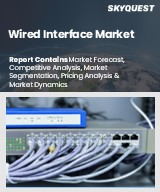
세계의 유선 인터페이스 시장 규모는 2023년에 205억 달러에 달하며, 예측 기간(2025-2032년)의 CAGR은 12.1%로, 2024년 229억 8,000만 달러에서 2032년에는 573억 1,000만 달러로 성장할 전망입니다.
세계의 유선 인터페이스 시장은 가전, 자동차, 산업 자동화, 데이터센터 등 다양한 분야에서 고속 데이터 전송, 저지연 통신, 다중 프로토콜 지원에 대한 수요가 급증하면서 큰 폭의 성장이 예상됩니다. USB4 v2.0, PCIe Gen 6.0, Thunderbolt 5와 같은 첨단 인터페이스의 등장은 더 빠른 장치 통신을 촉진하는 한편, 혁신적인 설계를 통해 충전, 디스플레이, 데이터 전송 기능을 통합하고 있습니다. 이러한 추세는 여러 표준의 PHY와 에너지 효율이 높은 인터페이스 컨트롤러의 현저한 통합을 보여주며, 호환성을 높이고 전력 소비를 최소화하고 있습니다. 그러나 하위 호환성 문제, 고급 프로토콜 IP의 높은 비용, 소형화 제약 등 여러 가지 제약으로 인해 신흥 시장의 소규모 OEM의 채택을 방해할 수 있습니다. 그럼에도 불구하고 디지털화와 대역폭에 대한 수요는 계속해서 시장을 주도할 것입니다.
Global Wired Interface Market size was valued at USD 20.5 billion in 2023 and is poised to grow from USD 22.98 billion in 2024 to USD 57.31 billion by 2032, growing at a CAGR of 12.1% during the forecast period (2025-2032).
The global wired interface market is poised for significant growth, propelled by a surging demand for high-speed data transfer, low latency communication, and support for multiple protocols across various sectors, including consumer electronics, automotive, industrial automation, and data centers. The advent of advanced interfaces such as USB4 v2.0, PCIe Gen 6.0, and Thunderbolt 5 is fostering faster device communication while innovative designs are converging charging, display, and data transfer functions. Trends indicate a notable integration of multi-standard PHYs and energy-efficient interface controllers, enhancing compatibility and minimizing power consumption. However, hurdles like backward compatibility challenges, high costs of advanced protocol IP, and constraints in miniaturization may impede adoption among smaller OEMs in emerging markets. Nonetheless, the demand for digitalization and bandwidth continues to drive the market forward.
Top-down and bottom-up approaches were used to estimate and validate the size of the Global Wired Interface market and to estimate the size of various other dependent submarkets. The research methodology used to estimate the market size includes the following details: The key players in the market were identified through secondary research, and their market shares in the respective regions were determined through primary and secondary research. This entire procedure includes the study of the annual and financial reports of the top market players and extensive interviews for key insights from industry leaders such as CEOs, VPs, directors, and marketing executives. All percentage shares split, and breakdowns were determined using secondary sources and verified through Primary sources. All possible parameters that affect the markets covered in this research study have been accounted for, viewed in extensive detail, verified through primary research, and analyzed to get the final quantitative and qualitative data.
Global Wired Interface Market Segments Analysis
Global Wired Interface Market is segmented by Component Type, Data-Rate Class, Application, End-User Industry and region. Based on Component Type, the market is segmented into USB, HDMI, DisplayPort, Thunderbolt and Others. Based on Data-Rate Class, the market is segmented into Below 5 Gbps, 5-20 Gbps, 20-40 Gbps and Above 40 Gbps. Based on Application, the market is segmented into Smartphones and Tablets, PCs and Gaming Consoles, TVs and Digital Signage, VR/AR and Wearables and Other Applications. Based on End-User Industry, the market is segmented into Consumer Electronics, Automotive, Industrial, Healthcare, IT and Telecom and Other End-User Industries. Based on region, the market is segmented into North America, Europe, Asia Pacific, Latin America and Middle East & Africa.
Driver of the Global Wired Interface Market
The increasing demand for high-speed data transfer across various sectors such as automotive, industrial automation, and consumer electronics is a significant driver of the Global Wired Interface market. Automotive manufacturers are notably integrating advanced wired technologies like Automotive Ethernet and USB4 to enhance their capabilities in infotainment systems, advanced driver-assistance systems (ADAS), and real-time diagnostics. These applications necessitate robust, low-latency connections that only wired interfaces can provide, further emphasizing their importance in facilitating high-bandwidth communication. As industries continue to evolve and require more efficient data transfer solutions, the reliance on sophisticated wired interfaces will only grow, fueling market expansion.
Restraints in the Global Wired Interface Market
The expenses associated with implementing wired infrastructure, particularly in older legacy environments, present significant challenges for the Global Wired Interface market. Many businesses, including mid-sized manufacturers, frequently postpone upgrades to industrial Ethernet systems due to the prohibitive costs related to installation and ongoing maintenance. The integration of wired technologies with outdated machinery often necessitates expensive converters and can lead to considerable downtime and the need for retraining employees. These factors create obstacles for small to medium enterprises, ultimately hindering the widespread adoption of wired solutions across various industries.
Market Trends of the Global Wired Interface Market
The Global Wired Interface market is witnessing significant transformation driven by the escalating demand for bandwidth and the convergence of protocols. As data-intensive applications, including AI, 8K streaming, and AR/VR, gain traction, innovations in wired interface technologies are addressing the necessity for higher bandwidth and reduced latency. In the forecast period of 2024-2025, industry leaders are set to launch multi-protocol PHYs that incorporate support for USB4 v2.0, Thunderbolt 5, PCIe Gen 6.0, and DisplayPort 2.1 within a single chip. This advancement not only facilitates faster data transfer but also streamlines design processes for next-generation computing, gaming, and enterprise devices, further boosted by the merging of display, data, and charging capabilities in sleek devices such as ultra-thin laptops and tablets.